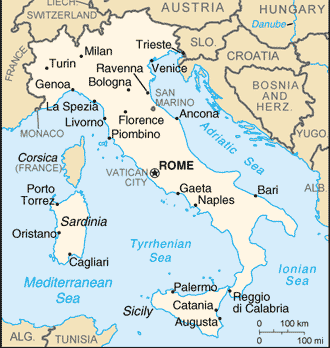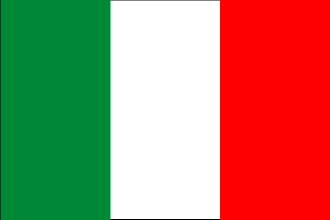
|
Italy
Background:
Italy became a nation-state in 1861 when the city-states of the peninsula,
along with Sardinia and Sicily, were united under King Victor Emmanuel. An era
of parliamentary government came to a close in the early 1920s when Benito
Mussolini established a Fascist dictatorship. His disastrous alliance with Nazi
Germany led to Italy's defeat in World War II. A democratic republic replaced
the monarchy in 1946 and economic revival followed. Italy was a charter member
of NATO and the European Economic Community (EEC). It has been at the forefront
of European economic and political unification, joining the European Monetary
Union in 1999.
Location:
Southern Europe, a peninsula extending into the central Mediterranean Sea,
northeast of Tunisia.
Area: Total: 301,230 sq km, note: includes Sardinia and Sicily, water: 7,210
sq km, land: 294,020 sq km.
Area - comparative: Slightly larger than Arizona.
Land boundaries: Total: 1,932.2 km, border countries: Austria 430 km, France
488 km, Holy See 3.2 km, San Marino 39 km, Slovenia 232 km, Switzerland 740 km.
Coastline: 7,600 km.
Climate and Terrain:
Climate: Predominantly Mediterranean; Alpine in far north; hot, dry in south.
Terrain: Mostly rugged and mountainous; some plains, coastal lowlands.
Natural resources: Mercury, potash, marble, sulfur, natural gas and crude oil
reserves, fish, coal.
People:
Population: 57,715,625.
Ethnic groups: Italian, includes small clusters of German-, French-, and
Slovene-Italians, and Albanian-Italians and Greek-Italians.
Religions: Predominately Roman Catholic with mature Protestant and Jewish
communities and a growing Muslim immigrant community.
Languages: Italian (official), German , French , Slovene.
Government:
Government type: Republic.
Capital: Rome.
Independence: 17 March 1861 (Kingdom of Italy proclaimed; Italy was not finally
unified until 1870).
Economy overview:
Italy has a diversified industrial economy with roughly the same total and per
capita output as France and the UK. This capitalistic economy remains divided
into a developed industrial north, dominated by private companies, and a less
developed agricultural south, with 20% unemployment. Most raw materials needed
by industry and more than 75% of energy requirements are imported. Over the
past decade, Italy has pursued a tight fiscal policy in order to meet the
requirements of the Economic and Monetary Unions and has benefited from lower
interest and inflation rates.
GDP - composition by sector: Agriculture: 2.4%, industry: 30%, services:
67.6%.
Statistics:
Telephones - main lines in use: 25 million.
Telephones - mobile cellular: 20.5 million.
Radio broadcast stations: AM about 100, FM about 4,600, shortwave 9.
Radios: 50.5 million.
Television broadcast stations: 358 (plus 4,728 repeaters).
Televisions: 30.3 million.
Internet users: 19.25 million.
Railways: Total: 19,786 km.
Highways: Total paved: 668,669 km.
Airports: with paved runways: 97, with unpaved runways: 38.
Heliports: 4.
Return to Visiting Locations
|

